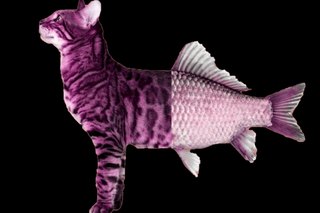
The Psychology of Catfishing
It’s all exhilarating escapism until someone asks for a video call.

One of my favorite Internet lores remains the story of model Cindy Kimberly, who readily supplied her fans with photos of herself holding up a fork, or a peace sign, so they could grift a few sugar daddies for some extra cash. Her fans were obviously catfishing — luring someone into a romantic or sexual situation by pretending to be someone they’re not on social media platforms. But, though we’re all sure that lying about one’s identity is not a good or truthful thing to do, this hot-girl Robin Hood situation doesn’t feel all that wrong or bad. Neither does the story of Justin Payne — a construction worker moonlighting as a pedophile hunter — who pretended to be a 9-year-old on messaging platforms in order to lure potential child sexual abusers, confront them, and report them to the police.
People have always lied about their identities to get what they want. But catfishing, the modern, virtual iteration, is fascinating because of how easy it is to execute than ever before, coupled with how easy it has always been to choose to believe something that almost looks real and feels good, rather than digging deeper. However, what motivates an individual to invent an entire alternate identity, with its own entire alternate universe is mainly escapism, play-acting and the thrill of a good grift.
Related on The Swaddle:
Of Ghosts and Draculas: Modern Dating Trends, Explained
The phrase “catfishing” apparently owes its genesis to Catfish, the documentary that inspired the MTV show Catfish. The documentary revolved around Nev, a person being catfished by a woman named Angela, who creates multiple half-truths and lies in order to stay in touch with Nev. Angela’s husband Vince calls his wife a catfish — he says, “They used to tank cod from Alaska all the way to China. They’d keep them in vats in the ship. By the time the codfish reached China, the flesh was mush and tasteless. So, this guy came up with the idea that if you put these cods in these big vats, put some catfish in with them, and the catfish will keep the cod agile. And there are those people who are catfish in life. And they keep you on your toes. They keep you guessing, they keep you thinking, they keep you fresh.”
Researchers found that loneliness, struggles with social connection, and dissatisfaction with one’s physical appearance led people to catfish. Some queer individuals are known to catfish as it gives them a safe opportunity to explore their sexuality. Others use catfishing for revenge, or as vigilantes, like Justin Payne and his pedophile hunting. For others, catfishing is merely a way to grift for money. Previously, this would involve the victim not knowing that they’re being scammed, but like all things that exist, this scamming kind of catfishing is now a kink in which people pay a dominatrix to catfish them and financially dominate them. Boredom is also a motivator to catfish, which can lead to a slow, spiraling addiction to catfishing.
No matter how many reasons there are for someone to catfish another, onecommonality between catfishers could be the online disinhibition effect, in which, the potential for anonymity loosens up social and moral codes. This means the need to be a certain way to fit into society seems distant, freeing up mental space to explore the dimmer, darker bits of our personalities without fearing stigma.
Whether used to sniff out criminals or used to fulfill a fantasy or used to hurt innocent individuals, catfishing is a mainstay form of manipulation in the increasingly isolated society we live in. All that helps is to remain vigilant and skeptical of red flags, like the person not wanting to meet in person or video call, or displaying a suspicious interest in banking information.
Aditi Murti is a culture writer at The Swaddle. Previously, she worked as a freelance journalist focused on gender and cities. Find her on social media @aditimurti.
Related


Odisha’s Maternity Benefits Are Touted as a Success; That’s Only Half the Story
